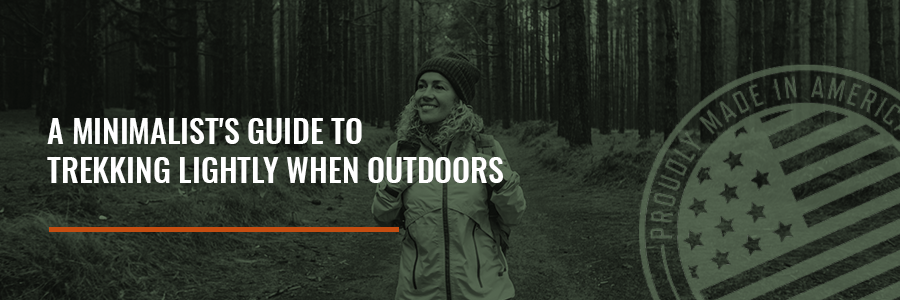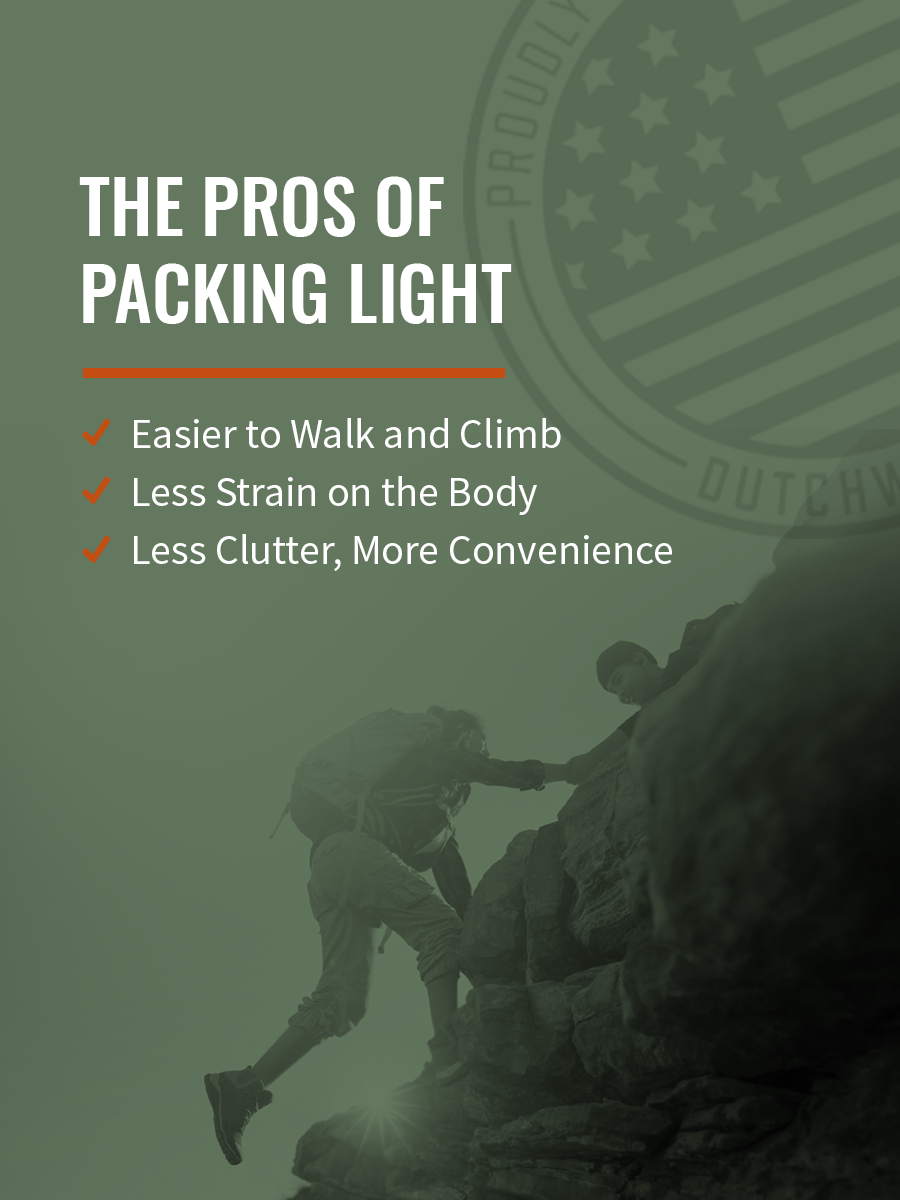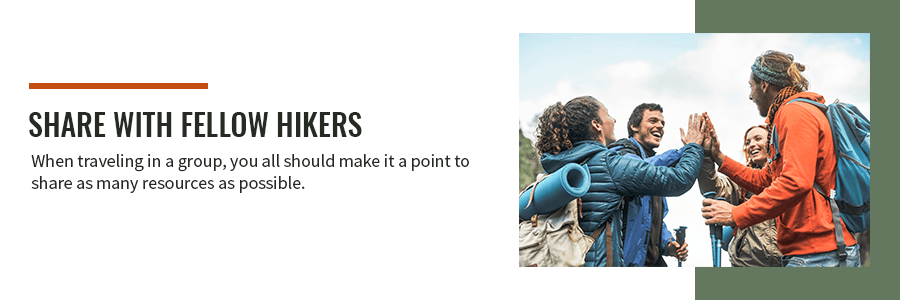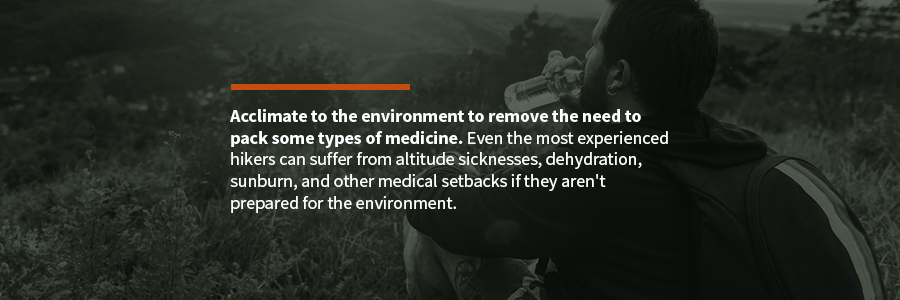March 4, 2020
posted in: Hammock Beginner, Resources

If you’re like our crew at DutchWare, then you were born to explore the outdoors. Even if you’re wearing comfortable clothing and durable footwear, an overloaded backpack can both weigh and wear you down. That’s why we suggest backpackers learn how to create a pack that contains everything you need and leaves behind excess bulk.
Whether you’re heading out for a week-long excursion across one of our beautiful national parks or simply spending a weekend close to home camping in the local forest, you’ll want your packing to be lightweight and efficient. In this guide, we’ll discuss the benefits of packing light and how to pack only what you need for your next trip.

The Pros of Packing Light
Trust us — we’ve encountered a handful of obstacles out on our adventures that could have been easily solved had we packed a certain item. Although many of us want to ensure we have all of our resources available should we need them, we must also be realistic with our packing. Overpacking can sometimes harm us more than it helps us. We’ve found that packing lighter immediately provides us with three fantastic benefits:
1. Easier to Walk and Climb
Exploring new places means potentially encountering diverse terrain. If you’re taking a full pack or even a day pack with you on the hiking trails, you need to be equipped with everything you need while still being able to fully maneuver your body across uneven terrain, up hills, and across narrow paths. Packing lightly can make it easier to walk and climb, enabling you to keep your balance and move through narrow trails.
2. Less Strain on the Body
Heavy backpacks have been shown to potentially cause significant strain and even damage to our nerves, soft tissues, and bones. Although it may be nearly impossible to camp or hike without a backpack, keeping a light load and wearing the backpack properly can reduce the potential of and severity of damage to the body.
3. Less Clutter, More Convenience
When you’re out in the wilderness, you need to be able to instantly access all of your supplies at a moment’s notice. Regardless of how organized you keep your pack, too many items create obstacles between you and the resources you need. Don’t inconvenience your group by stopping to unpack and repack your bag just to access bandages or a clean pair of socks. Pack wise, pack light and keep your pack free of clutter.
8 Tips for Trekking Lightly
1. Stick to the Essentials
If it’s better for your body to keep a light pack, but important for your trek to have certain resources on-hand, how can you determine what should be packed and what should be left at home? No matter if it’s your first time camping or if you’ve already racked up thousands of miles off the beaten path, you should always create a comprehensive packing checklist immediately after you plan your adventure.
Each piece of equipment has its function. However, some of these resources aren’t necessary for your trip, no matter how efficient they may be. All items will fall into two categories — essential and optional — and will be categorized based on the specific needs of each trip. For example, trekking through California’s Yosemite National Park in the winter will require certain essential items that aren’t needed when camping in Florida’s Ocala National Forest in the summer.
Day trips, weekend getaways, and week-long excursions each have essential gear. Thankfully, by understanding why these items are essential or optional for each context, you can plan for every adventure. Generally, these items will likely fall into your “essentials” category:
- Weatherproof jackets
- Sunglasses and hats
- Extra socks and underwear
- Thermal underwear
- Flashlights or headlamps
- Pocket knives
- First aid kit
- Whistle
- Insect repellent and sunscreen
- Water filters
- Cooking supplies
- Fire starters
All of these pieces of equipment seem essential, and in some cases, it’s wise to always have them on hand. However, there are a few instances in which some of these essentials might not be necessary for certain trips, like:
- Excessive sets of clothing aren’t necessary if you’re camping for the weekend. Pack only clean socks, underwear, and one or two shirts.
- Trekking poles, GPS, water filters, and fire starters should be considered optional equipment for those who will sleep in a hotel and only hike minimal trails during the daytime.
- Multiple pairs of shoes can quickly weigh down your pack. It’s better to have one versatile pair of hiking shoes and to bring slip-ons or sandals for sitting around a campfire.
Before you pack up your bag, ask these questions about each item:
- When and why would I use it?
- Can I use someone else’s instead?
- Is this an essential or a “just in case” item?
- Is this item vital enough to warrant the extra weight in my pack?
2. Load Up on Multipurpose Tools
If you’re still uncomfortable with having to leave certain items at home, you may be in luck — there are many multipurpose tools that give you peace of mind without adding significant weight to your pack. By choosing the most efficient multipurpose tools that are suited to the type of adventure you seek, you can leave larger items at home and rely on these lightweight resources when the situation arises.
The most important detail you need to consider when choosing which tools you’ll bring along in your pack is whether or not a specific tool is an absolute necessity. For example, a multipurpose tool may have a small knife or saw, which is helpful in the event that you need to cut through thread or fabric. However, it won’t replace a backpacking saw or hatchet that you’ll need to cut firewood.
The two features of a multipurpose tool you need to consider are the implements and the size. Thankfully, there are so many varieties available that you should have no trouble finding one that provides the functionality you need with the compact size you desire.
Many tools will feature a small knife, pliers, screwdrivers, bottle openers, and scissors. Keep in mind that, although smaller sized multi-tools will add less weight, larger multi-tools may provide more robust functionality. For instance, a keychain-sized multi-tool may be ideal for day-trips, while a larger multi-tool may be necessary for a week spent out in the wilderness.
Multipurpose tools are also helpful for group travelers. Before traveling, discuss which multipurpose tools each person has and determine which ones may be the most effective. Two people carrying the same multipurpose tool may be excessive, but four people each carrying a unique multipurpose tool affords all members of the group with versatile yet lightweight resources.
3. Pack a Hammock Instead of A Tent
Even if you’re only spending a single night in the great outdoors, you’ll need suitable sleeping arrangements. Depending on which resource you use, you can limit the amount of weight you add to your pack.
Should you use a hammock when traveling? That depends on the type of experience you desire. In some cases, such as traveling with a group, a family, or with children, you may not have an option. However, if you can choose between a sleeping bag, a tent, and a hammock, many outdoor explorers love the benefits that a lightweight hammock provides.
The first thing you need to consider is the weight of a hammock versus a tent. Is a hammock lighter than a tent? In many cases, it can be. Hammocks constructed with lightweight fabrics may weigh less than a tent, especially if these fabrics are breathable and wick moisture away.
You also must keep in mind that you may need to carry other pieces of equipment with a tent, such as poles and stakes, which increase the weight of your pack. Hammocks only require a rope, two carabiners, and an optional foam pad.
A hammock provides simple and readily-available bedding, and there are many benefits to sleeping in a hammock. You receive maximum air circulation to keep your body temperature regulated, your body is perfectly positioned to reduce pain and strain, you can fall into a deeper and more restful sleep, and it may even help those suffering from insomnia.

4. Share With Fellow Hikers
Those who wander this world alone are treated to a unique trekking experience that will change their lives forever. Unfortunately, one drawback of traveling alone is you’re responsible for all of your gear. Thankfully, those traveling with a group or on popular routes can potentially lighten their packing by sharing supplies with fellow hikers.
When traveling in a group, you all should make it a point to share as many resources as possible. Not only will it be easier but choosing to utilize fewer resources can also ensure that you’re hiking as sustainably and as environmentally friendly as possible.
Before you head out on your adventure, gather your group and compare your packing lists. Each person’s individual needs will be different, but there will usually be a number of supplies that all hikers will carry in their packs. When comparing lists — and if possible, comparing gear weights — consider the following:
- Are multiple people carrying an item that the group only needs one of?
- Could an item be upgraded to a larger size to accommodate more people using it?
- Are there are any communal items that can be broken down and split between packs?
For example, everyone will need their own fork and plate, but your group could save room by sharing a frying pan or pot. Likewise, you only need one emergency bivvy, gear repair set, first-aid kit, and water treatment filter. If you plan together well enough, you could also share food and split supplies between all backpacks, so everyone’s pack gets lighter as the trip continues.
Sharing supplies will make your group a stronger unit. Most importantly, it allows you to have as minimal of an impact on the environment as possible.
5. Learn Survival Skills
Survival skills can save your life in the wild, but they can also save your back and shoulders from an overpacked bag. Developing certain skills can remove the need to carry certain items. Learning how to start a fire can remove the need to carry a fire starter. While it always helps to have a few waterproof matches in your pack, you may not need to bring along a fire starter if you or a member of your group is experienced at starting fires in the wild.
Knowing which foods provide sustained nourishment and energy can condense your food supply. You need to consume thousands of calories during your trek, but you also need to make sure you’re providing your body with the nutrients it needs to endure the trip. Knowing which foods will give you sustained energy will ensure this added weight is worth every ounce.

Acclimate to the environment to remove the need to pack some types of medicine. Even the most experienced hikers can suffer from altitude sicknesses, dehydration, sunburn, and other medical setbacks if they aren’t prepared for the environment. Acclimating yourself to a higher altitude level, spending time outdoors in the sun, and exercising properly can prepare your body to endure the challenges of your environment and limit the amount of medicine and first aid supplies you need to pack.
Knowledge is always your most useful resource in the great outdoors. Regardless if a specific survival skill will free up space in your pack, all outdoor enthusiasts should strive to learn as much as they can about staying safe, healthy, and smart in the wild. While millions of hikers and backpackers enjoy their travels without issue, an emergency situation can occur at any time to anyone in any location. Learn as many survival skills as you can and pack accordingly.
6. Upgrade Old Gear
When’s the last time you upgraded the gear in your pack? Some travelers stick to the theory “if it’s not broken, don’t fix it,” while other travelers who’ve invested in higher-priced equipment want to get the most mileage out of their gear. Both examples are logical reasons to keep your current gear, but upgrading to new equipment could significantly make packing easier.
Older gear tends to be dated and heavier. Outdoor enthusiasts are always on the hunt for solutions to common backpacking problems, which means outdoor equipment companies are constantly improving upon their designs. More recent products may be designed with enhanced durability, functionality, and other features, yet their overall weight can be substantially less.
There are many outdated pieces of gear that are likely adding excess weight to your pack. For example:
- Bulky water bottles: Stainless steel water bottles can be traded for collapsible bottles that take up less room in your bag.
- Unnecessary clothes: Many hikers forget their clothing presents an area to trim excess weight from their bag. Lightweight, breathable clothing offers a range of benefits, including reducing your pack load. Even long underwear and jackets are available to keep you warm in low temperatures without adding bulk to your bag.
- Sleeping bag vs. hammock vs. tent: One critical piece of gear you can upgrade is your old sleeping bag or tent. This should be a huge consideration, especially since there are many lightweight hammock options available that are durable, breathable, and designed to support your body properly. Upgrading your old sleeping equipment to a new lightweight hammock will help you wake up feeling refreshed.
Keep in mind that new gear may also be more reliable, convenient, and versatile than your current equipment. If you’re looking for a completely customized pack, consider making your own gear. DutchWare carries a variety of fabrics, hardware, insulations, kits, rolled goods, rope, stoves, and other tools to help you construct lightweight gear that caters to your unique trekking needs.
7. Plan Ahead
One of the best ways to figure out what your essentials are is to plan ahead. Mapping out where you’ll be at which times, checking the weather, considering the general climate and more can give you a clearer idea of what gear you need for the trip.
A great thing to consider during your planning stage of the trip is how to divide gear among everyone. When you’re out with a group, you need to communicate, so you don’t double up on equipment. You don’t need two stoves, too many shelters or duplicates of a variety of other items. More people also means more ways to divide the weight of the gear.
When you’re backpacking by yourself, you have to carry everything you need. If you’re traveling with others, you can share the weight of the gear that you’ll be sharing.
8. Keep Track of Unused Items
Even if you carefully plan your gear list, you may still find that you bring gear you don’t need. After past trips, is there always an item or two that makes its way to the bottom of your backpack? Do you always bring a paperback you plan to read but never get around to?
Consider leaving items like these at home for your next trip. If you’ve gone on multiple trips and haven’t used something once — or only a couple of times — then it’s not as essential as you might have initially thought it was.
Lightweight Hammock Options and Minimalist Equipment From DutchWare
An adventure like no other deserves equipment like no other. DutchWare is ready to help you customize your pack will efficient, lightweight resources that will endure adventures of every sort. Our selection of lightweight hammock options, camping gear, food, and DIY materials will help you design your pack with every essential resource while adding as little weight as possible.
Browse our online inventory, learn helpful packing tips, and design your own gear today. Speak with one of our experienced outdoor experts for more information.
Written & Reviewed by Josh


